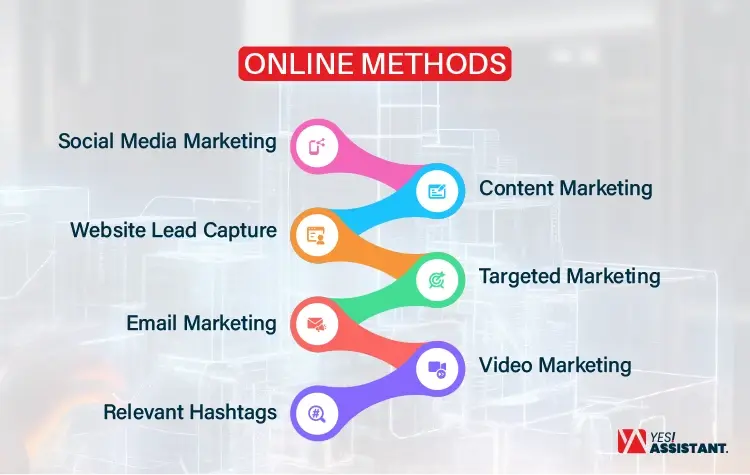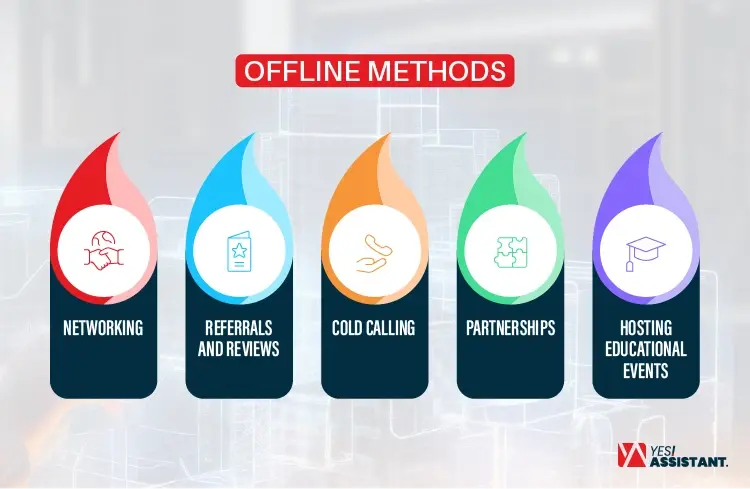
How to Create an Effective Real Estate Prospecting Guide
Identifying and reaching out to potential clients interested in buying or selling property is known as real estate prospecting. It is an important activity to build and maintain a steady flow of leads, increase market visibility, and maintain strong and long-term relationships with clients. It also helps in adapting to market changes and professional growth, which is why it is essential for you.
Today, we will talk about how you can create an effective real estate prospecting.
What's Inside
How to Set Clear and Effective Prospecting Goals
To set clear and effective prospecting goals in real estate, defining clear targets, establishing how to track progress, ensuring goals are attainable given individual circumstances, aligning them with overall business objectives, and setting deadlines are the most important activities. Here’s how you can set clear and effective prospecting goals in real estate:
Understanding Your Goals
At first, you need to understand your motivations for setting specific goals. You need to estimate and realize what you are ultimately trying to achieve in your real estate business. By clearly understanding what you want to achieve, you can move forward in a calculated manner with more confidence.
SMART Analysis
This is a step-by-step process that helps individuals and organizations define clear and attainable objectives. Here’s how it’s done in the case of setting prospecting goals:
- Specific: Make your goals more number-specific. Instead of uncertain goals like “get more leads,” be precise and put it like, “Increase lead generation from social media by 25% in the next quarter”.
- Measurable: Define how you’ll track your progress. If your goal is to increase leads, specify the metrics you’ll use, like website traffic, social media engagement, and contact form submissions.
- Achievable: Make sure your goals are realistic and attainable given your resources, skills, and market conditions. Setting overly ambitious goals can lead to discouragement in case you can not attain them.
- Relevant: Align your prospecting goals with your overall business objectives. For example, if your focus is on luxury properties, your prospecting efforts should revolve around that market segment.
- Time-bound: Establish a specific deadline for achieving your goal. This creates a sense of urgency and helps you prioritize your activities more.
Taking Action According to the Goals
Take the specific steps needed to reach your goals. For example, if your goal is to increase your online presence, take actions like posting regularly on social media, optimizing your website for search engines, and engaging with online communities in order to reach your target audience.
Track Progress and Evaluate Results
Monitor your progress toward your goals regularly. You can use a CRM or spreadsheet to track key metrics like the number of contacts made, appointments scheduled, and leads generated. Analyze your results to identify what’s working and if anything needs improvement. This will help you refine your prospecting strategies and improve your effectiveness.
Seek Feedback and Support
Don’t hesitate to ask for feedback from colleagues, mentors, or your broker. Their insights and reviews can help you identify areas for improvement and stay on track. Also, they can support you in your business by providing important guidelines.
Stay Consistent
Consistent effort is very important for success in real estate prospecting. Develop a routine and stick to it, even when you face challenges. Consistency is key, so you can definitely be successful in this by being consistent with your work routine.
Identifying Your Ideal Real Estate Client: Building Accurate Personas
Patient and consistent research is important in order to identify your ideal real estate client and build accurate personas. It helps you adjust your marketing strategies and messaging to reach your ideal clients, leading to more effective engagement and conversions. Here’s how you can do so:
Research and Data Collection
At first, you need to do a thorough research of your audience to know who is the most potential customer and is more likely to convert to a lead. This research mainly includes:
- Demographic Information: Understanding factors like age, income, family status, and lifestyle preferences helps you adjust your marketing efforts and offerings to specific buyer or seller groups. This increases the chances of successful conversions and efficient use of resources.
- Key Interests: When setting real estate prospecting goals, customers are primarily interested in finding the right property, achieving a good investment, and ensuring a smooth transaction process. Key interests of your customers include a good location, desirable features, a fair price, and a trustworthy agent who can guide them through the process.
- Behaviors: By understanding how potential clients interact with properties and the market, you can identify your ideal clients and adjust your strategies for better lead generation and conversion rates accordingly. This involves examining demographics, preferences, and past behaviors to identify patterns and predict future needs.
- Psychographics: Analyzing psychographics helps in setting effective real estate prospecting goals because they provide insights into what motivates and influences potential clients. Understanding a customer’s personality, lifestyle, values, and interests allows agents to tailor their marketing and sales strategies for better results.
- Challenges or Pain Points: Customers often face several challenges when setting real estate prospecting goals, like a lack of clarity in the market, difficulties in understanding the process, and the need for more personalized guidance. The research helps you to identify these customer pain points and help them where needed.
Creating Buyer Personas
Develop detailed, fictional profiles of your ideal clients. Give each persona a name, a face if possible, and a backstory to make them relatable. This will help you realize your customers better as well as your target audience.
Targeted marketing is also important here. Use these personas to make your marketing messages and content more specific. For example, you might create blog posts, social media content, or email campaigns specifically for each persona.
Goals and Quotes
You also need to see what your customer wants to achieve and what your customers say about their goals. These goals can be categorized into increasing sales, expanding their market reach, growing their investment portfolio, or improving their listing presentations.
Data and Feedback
Start by analyzing your existing clients. Review your past and current clients’ data to identify common characteristics and trends. You may also conduct surveys and interviews to gather qualitative data from your target audience. This can provide valuable insights into their needs, preferences, and pain points.
Now, analyze the market research data to understand the demographics and psychographics of your target market. Gather new data and seek feedback to continuously refine your personas to make sure they remain accurate and relevant.
Elevator Pitch
This is a concise and compelling introduction of yourself and your services, which is needed to quickly capture attention and generate interest. It is basically a summary of what you can do for your customers. Identify your target audience, develop your value proposition, and structure your pitch.
The Best Prospecting Methods to Grow Your Real Estate Business
Combining online and offline prospecting strategies is essential to effectively grow a real estate business. In this era of increased use of social media, the use of online marketing methods is recommended more, along with a few necessary offline methods. But as businessmen stay busy with other important activities most of the time, it is best to hire a virtual assistant for your real estate business.
The best online and offline methods to grow your real estate business are described below:
Online Methods
As of now, in the time of increased use of technology, online marketing methods are preferred more. The best methods are described below:

- Social Media Marketing: Share valuable content and engage in relevant conversations on platforms like Facebook, Instagram, and LinkedIn to connect with potential clients.
- Content Marketing: Create informative blog posts, videos, and newsletters to establish yourself as a knowledgeable resource. This will help you attract potential buyers and sellers.
- Website Lead Capture: Make sure that your website is optimized to capture leads through contact forms, property inquiries, and engaging content.
- Targeted Marketing: Invest in online advertising campaigns on platforms like Google Ads and social media to reach specific demographics and interests.
- Email Marketing: Build an email list and send out targeted campaigns with valuable information, property updates, and personalized messages. You need to make sure that the emails are relevant to your business and the receiver’s needs.
- Video Marketing: Showcase your properties to your potential clients, market insights, or provide virtual tours by creating engaging video content.
- Relevant Hashtags: Use relevant real estate hashtags on social media to increase visibility and reach a wider audience who are more focused on real estate.
Offline Methods
It is a good tactic to use offline methods alongside online methods as well. Here are some effective offline methods:

- Networking: Build relationships with potential clients and industry professionals through networking events, open houses to showcase properties, and community involvement to participate in local events.
- Referrals and Reviews: Never hesitate to ask for referrals and reviews from past clients, friends, and family, as this feedback is a powerful source of leads.
- Cold Calling: Make direct calls to potential clients, but make sure your approach is respectful of their time and privacy.
- Partnerships: Collaborating with local businesses in your area might be very effective as well. This can help you reach a wider audience and generate more leads.
- Hosting Educational Events: Offer free real estate classes or workshops to share your expertise, values, and benefits of your product or service to attract potential clients.
How to Create a Prospecting Schedule That Actually Works
It is essential to create an effective real estate prospecting schedule. For this, focusing on consistent and targeted outreach, leveraging diverse methods, and maintaining a structured follow-up system are important. Prioritize time for lead generation and nurture relationships with potential clients. Here’s the step-by-step process of how you can create a prospecting schedule that actually works:
Step 1- Setting Clear and Achievable Goals
To set and achieve goals in real estate, focus on clarity, measurability, and a realistic approach. You can do so by using the SMART analysis, as we have mentioned earlier, to define your objectives, break them down into smaller steps, and track your progress. Regularly assess your current situation, research the market, and be prepared to adjust your strategies as needed.
Step 2- Identifying Your Target Audience
You need to identify the specific individuals or businesses that a real estate professional or company aims to reach with their services. You can achieve this by looking for characteristics like demographics, income, lifestyle, and property preferences, and finding the most likely candidates to purchase or invest in the offered properties. Understanding and defining your target market is crucial for effective marketing and business strategy.
Step 3- Diverse Prospecting Methods
Use both online and offline methods in this process. Combine various techniques like cold calling, email marketing, social media engagement, content marketing, and networking events. By doing this, you can effectively reach both the online and offline audience.
Step 4- Scheduling Time for Prospecting
This is important to maintain a steady pipeline of potential clients, leading to more listings and sales. Allocate specific times each day for prospecting activities and protect that time from distractions. Consider using a calendar or CRM to schedule tasks and reminders. You need to determine the best times, set clear time blocks, and prioritize high-quality leads.
Step 5- Follow Up
Following up is an important activity to generate leads here. Look for leads with the highest potential impact, assess their level of engagement, and consider their timelines. Prioritize leads that show high engagement, have clear timelines, or are financially ready, and respond to referrals and repeat clients promptly. You may use various follow-up strategies like a multi-channel approach, automated drip campaigns, personalized communication, etc., for this purpose.
Step 6- Tracking Results
Now, you need to track lead generation, conversion rates, and the overall return on investment (ROI) of your prospecting efforts. Monitor your prospecting activities regularly and analyze your results to identify what’s working and what needs improvement. You can use Key Performance Indicators (KPIs) for this purpose as well.
Step 7- Patience and Consistency
Patience and consistency are essential in order to run your real estate business properly and gain success. Assess your prospecting plan regularly and make adjustments and improvements as needed to optimize your efforts to stay on track.
Conclusion
Creating an effective real estate prospecting requires a lot of research, methods, effort, patience, and consistency. It is a process that requires you to set clear and realistic goals, identify your potential clients, use both online and offline prospecting methods, and have a specific schedule for prospecting activities. By following our guidelines, you will be able to create an effective real estate prospecting.
We provide active and professional guidelines for you to maintain your real estate business effectively. Stay connected with us for more advice and support.




